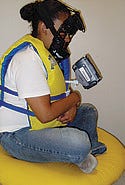August 1, 2009
R&D Digest
|
The participant sits cross-legged on the device, wrapping arms and legs around the center post, while resting his or her head on the headrest. |
A technology that records certain eye movements in complete darkness is giving researchers at the University of Florida (UFL; Gainesville) unique information about autism in children. The device records vestibulo-ocular reflex (VOR) eye movement, and more specifically nystagmus, an involuntary movement in which the eye moves rapidly in one direction and then slower in the other.
The vestibular system is an organ in the middle ear, connected to the cochlea, which senses linear and angular acceleration of the head. The system provides the body with a sense of balance and space. The VOR works to stabilize vision during head movement.
“When you turn your head to the right or left, it's sensing those movements,” says Tana Bleser, a graduate student in UFL's psychology department. “This vestibular information travels through very simple circuitry via the brain stem to ocular control centers. It's like a direct communication to your eye movement.”
Bleser developed the child-friendly eye-recording technology with Keith White, MD, associate professor of psychology at the university. They are testing the VOR reflex and its characteristics in children with autism during and after head rotation.
The concept for the device began when Bleser observed occupational therapy sessions as an undergraduate student. Her interest was sparked as she watched children with autism swing back and forth continuously without becoming nauseated. She thought there might be a correlation with the nature of their neural sensory and motor circuitry. In particular, she wanted to create a device that was more amenable to testing lower-functioning, nonverbal children with autism.
A standard device that tests VOR usually involves an awkward large chair with a headrest. According to Bleser, a child would either need to be strapped into the chair or sit on a parent's lap while being spun around. Bleser devised a sketch of a more comfortable and less cumbersome device to test the VOR of children with autism. It has fewer straps and wouldn't require the involvement of a parent.
The patent-pending device looks like a miniature merry-go-round and is about four feet in diameter. The child sits on a padded circular disk, rests the head (face first) against a headrest that has an opening in the center (like a massage table), and crosses his or her legs around a center post. The post spins on a brushless dc motor that is controlled by a computer interface. According to White, the motor is unusual because it has enough torque to be able to spin an adult. “We're pretty happy with its ability to accelerate and be able to provide the kind of velocity profiles that we are interested in testing,” he says. “I think it'll be a step in a direction that many [professionals] in clinical sites might be interested in having.”
A charge-coupled-device sensor video camera is mounted onto the center post, which is tilted forward 30 degrees to isolate the horizontal semicircular canals while the child is spinning. The camera is positioned so that it can record the eyes, through the headrest, as the head rotates. Its sensors have near-infrared illumination.
“We wanted to carefully control what the children would be able to see while they were being tested. It's pretty uncommon to test an autistic child in absolute darkness,” says White. “The fact is that when it's possible for a person to be looking at things, their visual feedback modifies their eye movement. We're interested in studying the eye movements specifically as they're influenced by the vestibular system, so removing [visual stimuli] for the person gives us a purer picture of the response.”
According to Bleser, using videonystagmography has enabled researchers to pick up some characteristics of the nystagmus in autistic children that have previously gone unreported. “We've seen some vertical components to their horizontal nystagmus, which to our understanding, shouldn't be there.”
Based on pilot data collection, Bleser and White are rebuilding their device to improve its accuracy, flexibility, and the way in which it can be controlled. Enhancements to the video cameras and software for analyzing eye movements will help them detect vertical components. It will also help distinguish whether they're reflexive, whether they are part of the nystagmus (which would indicate an aberration in VOR circuitry), or whether they're a voluntary vertical eye movement during rotation.
“Our hope [is] that in the future, there might be a very simple battery of tests that could be administered in a few minutes and give some amount of confidence of the assessment,” says White. It currently takes the researchers about 30 minutes to conduct a dozen different tests. White's goal, in addition to reducing the amount of tests, is to reduce testing time down to 10 or 15 minutes.
Ultimately, White and Bleser hope the test will provide a predicted value in aiding autism diagnosis and assessment. They're also interested in testing infants 6 months of age and younger, which could open the door to predicting autism risk. Copyright ©2009 Medical Device & Diagnostic Industry
About the Author(s)
You May Also Like



